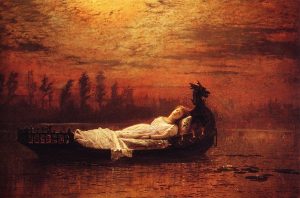
The Lady of Shalott is a great poem that when understood in its original context has a deeply impactful meaning. There are many interpretations but I want to get at the core theme of the poem by examining the tragic mistake the Lady of Shalott makes that ultimately leads to her death. Why does the Lady die? She pursues Lancelot down the river and ends up dying on her journey. Why does she does she pursue Lancelot? She says at the end of part two “I am half-sick of shadows”. This line has tremendous meaning. It suggests that she has had unfulfilled desires before Lancelot arrived. It also suggests that she is self aware, not the avatar of a supernatural ideal but rather a real person who is conscious of the decisions she is making. Her tone is also dismissive and maybe filled with a certain amount of frustration as well (understandable given her situation). I think the dismissiveness however is indicative of a certain amount of hubris. She dismisses and expresses some contempt for the “shadows”. What do these shadows represent? They are her understanding of the world because of the curse she has which prevents her from gazing upon the world directly. She calls her image of the world a ”shadow” and that she is “half-sick” of it. However these “shadows” are a necessary condition given the curse that she is beholden to. This is why her statement contains some hubris, she believes she is not beholden to the curse or that her desire is enough to overcome it.
Goblin Market has a similar theme of capitulation to desire. “We must not look at goblin men, We must not buy their fruits: Who knows upon what soil they fed Their hungry thirsty roots?”. There is the precedent set, the temptation and the succumbing to temptation eventually when the protagonist enjoys the goblin mens fruit. There is more explicit sexual imagery in Goblin Market in my opinion. “Clearer than water flow’d that juice; She never tasted such before, How should it cloy with length of use? She suck’d and suck’d and suck’d the more Fruits which that unknown orchard bore; She suck’d until her lips were sore”. In The Lady of Shalott the sexual desire is more innocent but more explicit.
The Lady of Shalott is an archetypal western story. In the western tradition dating all the way back to Euripides and his play the Bacchae it has been understood that freedom is the absence of or triumph over desire and that slavery is the capitulation to desire. Pentheus, the king of Thebes, is corrupted by the god Dionysus who lures him to his death by unleashing his carnal hunger. Pentheus loses control of himself and is consumed by perversion. In the end he is torn apart by his own mother, taking him for a lion in her own blind frenzy, who was also under the spell of Dionysus. The moral of the story and its traditional interpretation is that when you are consumed by desire you are held captive by a hedonism that transcends your being and ultimately leads to your destruction.
It’s interesting to consider the sexually charged tragic flaws of these characters. I had never thought of how lust and desire was what brought about their individual downfalls, but it truly speaks to Victorian ideals of marriage and women, that their lust results in their deaths. Women were not supposed to lust over men, and were especially not supposed to act on their desires, in contrast to the Lady of Shalott. It’s interesting that you mention how these characters felt unfulfilled – this reminds me of how housewives in the 50’s felt unfulfilled by spending their lives at home, and how this spurred different feminist movements in efforts to gain rights for women.
I like how you point out the theme of desire in both The Lady of Shalott and Goblin Market, however, I think they have an even more explicit relation. Desire seems to be such a common theme because the Victorian Era was so sexually restricted. These two texts reflect the frustration and pressures put on Victorian people, and help us to better understand what it would be like to have lived in the time period.
You bring up a lot of points about the concept of desire and how it plays into the texts we read. I found your initial discussion about The Lady of Shalott to be particularly interesting. You help display the victorian idea that following your desire always leads to a negative end. In this instance, Lady Shalott follows her desire for Lancelot and ends up dead. Another example of this idea can be found in Lady Audley’s Secret. Lady Audley follows her desire to be a wealthy upperclass respected women, but she ends up getting exposed for being a murderous deceiver, then everything falls apart.